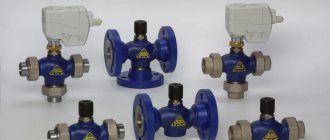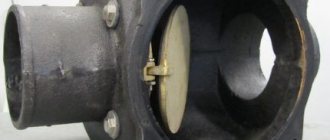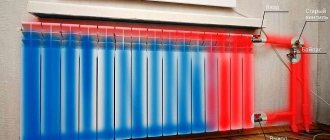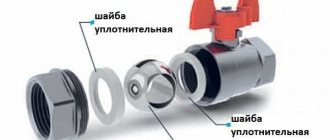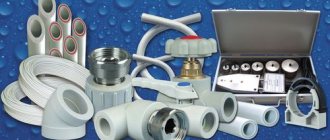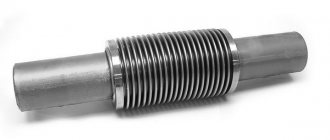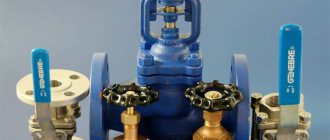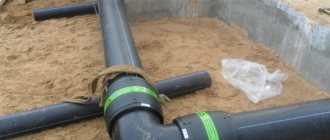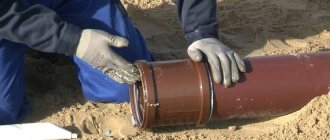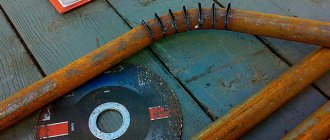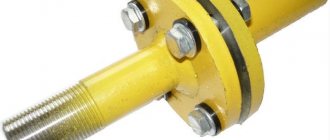To design and install plumbing, heating, ventilation systems and other utilities, it is necessary to select the correct shut-off and control valves. It is designed to regulate, open and stop the supply of working fluid or gas.
There are many types of valves that perform different functions:
- locking;
- safety;
- cutoffs;
- adjustments;
- mixing;
- prevent backflow.
They differ in their operating principle, diameter, installation method and other features that must be taken into account when designing engineering systems.
Valve types
The following types of valves are used in the pipeline depending on the requirements. The cost of a valve in a piping system is 20 to 30% of the total cost of the pipes. And the cost of a given type and size of valve can vary by 100%. This means that if you choose a ball valve instead of a butterfly valve for the same function, it may cost you more. Thus, the choice of valves has important economic implications as well as the operation of process plants.
- gate valve
- ball valve
- check valve
- cone valve
- ball valve
- butterfly valve
- needle valve
- hose valve
- pressure relief valve
Gate valve
The gate valve is the most common type of valve in any process plant. It is a linear motion valve used to start or stop the flow of fluid. During operation, these valves are either in the fully open or fully closed position. Valves are used in almost all liquid services such as air, fuel gas, feed water, steam, lubricating oil, hydrocarbons and all other services. The valve provides good shutoff.
Ball valve
A ball valve is used to stop, start and control the flow of a fluid. Ball valves are used in systems where flow control and sealing are required. A ball valve provides better shutoff than a gate valve and is more expensive than a gate valve.
Check valve
A check valve prevents backflow in a piping system. The pressure of the fluid passing through the pipeline opens the valve, while any change in flow closes the valve.
Cone valve
A cone valve is a quarter turn butterfly valve that uses a conical or cylindrical plug to stop or start flow. The disk has the shape of a plug, in which there is a passage for the passage of flow. A conical valve used as a two-position shut-off valve capable of providing tight shutoff of bubbles. The cone valve can be used in vacuum conditions for high pressures and temperatures.
Ball valve
A ball valve is a quarter-turn rotary valve that uses a ball-shaped disc to stop or start flow. Most ball valves are quick-acting types that require a 90° turn of the valve handle to operate. A ball valve is smaller and lighter than a valve of the same size and rating.
Throttle valve (butterfly valve)
A butterfly valve is a quarter-turn rotary valve that is used to stop, regulate, and start flow. The throttle valve has a short round body. The butterfly valve is suitable for large valves thanks to its compact, lightweight design that requires significantly less space than other valves.
Needle valve
Needle valves are similar in design to a ball valve, but the biggest difference is the sharp, disc-like needle. Needle valves are designed for very precise flow control in small diameter piping systems. They get their name from their pointed conical disk and corresponding location.
Hose valve
A hose valve is also known as a pinch valve. This is a linear motion valve. Used to start, regulate and stop the flow of fluid. It uses a rubber tube, also known as a clamp tube, and a clamping mechanism to control the fluid. The pinch valve is ideal for handling slurries, liquids with large amounts of suspended solids and systems that transport solid material pneumatically.
Pressure relief valve
A pressure relief valve or safety valve is used to protect equipment or piping system during times of overpressure or vacuum. This valve releases pressure or vacuum at a given set pressure.
Basic design elements.
The valve consists of a body, a cover (head), a seat, a valve (damper) and a rod (spindle) with a handwheel or an automatic device for moving it. The body combines all parts into one whole. The working fluid enters the valve from one side of the body, and the stem, which is located in the head along with the sealing gland, moves the valve, opening or closing the seat hole. The medium passes through the hole in the seat and flows out the other side of the body. In this case, the flow can maintain the direction of movement or turn at an angle.
Valve functions
The valve performs various functions in a piping system. Such as:
- stopping and starting fluid flow. Depending on whether the valve is open or closed, it allows process fluid to flow through or stops it flowing.
- throttling the fluid flow. Some valves allow fluid flow to be adjusted depending on the % open. Smaller hole above throttling and stuff.
- control of the direction of fluid flow. The multiport valve allows you to decide which way the fluid flows.
- regulation of flow or pressure in a pipeline system. Some of the automatic control valves maintain system flow and pressure by regulating opening and closing.
- Relieve pressure or vacuum in the piping system and equipment. The pressure and vacuum relief valve protects the process system from overpressure and under vacuum conditions.
Various types of valves perform these functions. These valves can be classified:
- by functional purpose
- by end connections
- How does it work
- by type of drive used
Classification of valves by function
In the table above you can see the types of valves and their functions.
The shut-off valve isolates or shuts off the flow of fluid when necessary. Gate valve, ball valve, piston valve, diaphragm valve, butterfly valve and pinch valve fall under this category.
A control valve that regulates the flow of fluid falls into the category of regulation. The control valves used are ball, needle, butterfly, diaphragm and pinch valves. Some valves serve dual purposes, for example a ball valve can be used as an insulator and also as a control valve.
A pressure and vacuum relief valve is used to prevent excess pressure and vacuum in the system, which can damage piping and equipment. A check valve, such as a swing and lift check valve, prevents backflow in the system. Whereas, some valves are designed for special purposes. For example, multiport, knife and linear blind valve.
Classification of valves based on end connections
Based on the end connection, the ends of the valve can be:
- screw or threaded, which connect to the corresponding thread on the pipe. A small diameter valve used to connect an instrument or as a sampling point has a threaded end
- Most valves used in pipelines have flanged ends.
- Butt weld valves are used at very high pressures and temperatures.
- Welded valves with plinth are used for low pressure
- Check valve and butterfly valves are available with plates and tips. These types of ends are used when space is limited.
You can see pictures of all these types of valve end above.
Classification of valves based on the way they open and close
| Valve type | Linear motion | Rotational movement | Quarter turn |
| gate valve | X | ||
| ball valve | X | ||
| rotary check valve | X | ||
| lift check valve | X | ||
| check valve with inclined seat | X | ||
| folding disc check valve | X | ||
| valve with built-in control | X | ||
| check valve | X | X | |
| ball valve | X | X | |
| hose valve | X | ||
| throttle valve | X | X | |
| cone valve | X | X | |
| diaphragm valve | X | ||
| safety valve | X | ||
| pressure relief valve | X |
Another way to classify a valve is how it opens and closes. Each valve opens and closes either in a linear motion, a rotary motion, or a quarter turn, which is nothing more than a rotary motion.
In the image below you can see the difference between the methods of opening the valve.
Linear motion valves use a closing element that moves in a straight line and cuts flow to start, stop, or regulate flow. The closure device may be a disk or a flexible material such as a diaphragm. Linear motion valves operate slower, but they provide a higher level of accuracy and stability in the position of the closure element.
Rotary motion valves rotate or turn the disc away from the pivot rod that holds the disc.
Rotating the stem 90° in quarter turn valves fully opens or fully closes the valve. Because of this fast turning, quarter turn valve operation is much faster than linear motion valves. Some rotary valves are also known as a quarter turn valve.
From the table it can be seen that ball valve, butterfly valve and plunger valve are rotary and quarter turn valves. Whereas swing check, tilt disc and other rotary valves are not quarter turn valves.
Classification of valves based on the types of actuators used
The final way to classify a valve is by the types of actuators used to transmit motion to operate the valve. The valve can be operated manually using a handwheel, lever, chain or gear. An external power source such as an electric motor, air, hydraulic fluid or solenoid is used to control the valve from the control room. The check valve operates automatically when subjected to reverse flow.
Purpose and design of the shut-off valve
Shut-off valves are used in everyday life and industry to completely shut off the flow of a working medium (liquid or gas). If an emergency occurs (accident, pipeline damage), the valve helps to isolate the damaged area for repair work.
Shut-off valve device
These products are installed on technical pipelines, main lines, and in household water and gas supply and heating systems. They are used in the gas, petrochemical industries, metallurgy, housing and communal services, etc.
DRIVES
Valves usually have one type of actuator or another. The simplest drive is a linear valve handwheel or a rotary valve lever. Special devices, such as a gear, can be used to rotate the handwheel. Power hydraulic or pneumatic drives are often used. These actuators can generate the significant forces required to move the stem of valves operating in high pressure systems or located in remote locations, as well as to control the operation of multiple valves from a single console. Spring loaded diaphragm valve actuators typically use compressed air. Compressed air moves the membrane with the rod in one direction, and the spring moves in the opposite direction. Electric motors are also often used as drives. see also
SERVO; AUTOMATIC CONTROL AND REGULATION.
Podlesny N.I., Rubanov V.G. Elements of the automatic control and monitoring system. Kyiv
, 1982
Valves are designs of pipeline fittings with a valve in the form of a flat or conical plate that moves back and forth along the central axis of the sealing surface of the body seat. Valves also include valve designs (rotary valves), in which the valve in the form of a plate moves in an arc. The arc described by the center of the valve is tangent to the axis of the seat, the center of the arc is located outside the hole of the seat, and the axis of rotation of the valve is perpendicular to the axis of the medium flow.
